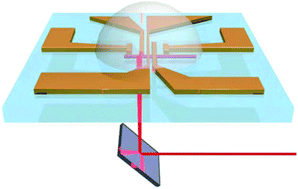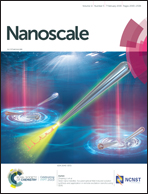High-performance solar-blind SnO2 nanowire photodetectors assembled using optical tweezers†
Abstract
One-dimensional semiconducting SnO2 nanowires with wide bandgaps are promising candidates to build many important optoelectronic devices. Because building these devices involves the assembly of nanowires into complex structures, manipulation of the active materials needs to be done with high spatial precision. In this paper, an optical tweezer system, comprising a spatial light-modulator, a microscope, and optical elements, is used to individually trap, transfer, and assemble SnO2 nanowires into two-terminal photodetectors in a liquid environment. After the assembly using optical trapping, the two ends of the SnO2 nanowire photodetectors, which are connected with the electrodes, were further stabilized using a focused laser. During exposure to 275 nm deep-ultraviolet light, the as-assembled photodetectors show a high Iph/Idark ratio of 2.99 × 105, a large responsivity of 4.3 × 104 A W−1, an excellent external quantum efficiency of 1.94 × 105, and a high detectivity of 2.32 × 1013 Jones. The photoresponse-speed of the devices could be improved further using passivation with a polymer. The rise and decay times are about 60 ms and 100 ms, respectively. As a result of this study, we can confirm that non-contact optical trapping can enable the construction of nanowire architectures for optoelectronic, bioelectronic, and other devices.



 Please wait while we load your content...
Please wait while we load your content...